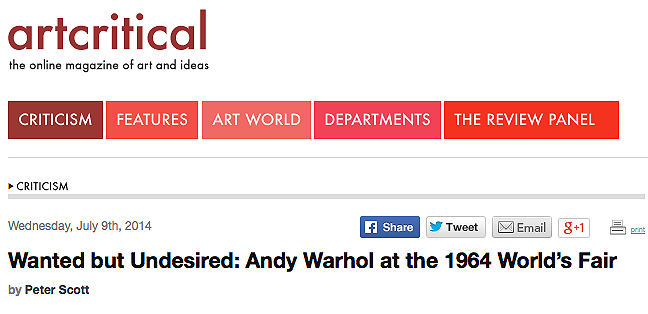
The facts are more or less clear. Invited by the architect Philip Johnson to propose a public artwork for the New York State Pavilion at the 1964 World’s Fair, Andy Warhol chose as his subject a set of mug shots from a New York police department bulletin of 13 Most Wanted Men. Silkscreened on a 20-by-20-foot grid, the resulting work was installed high above the fairgrounds on the oval Circarama building—an oversized rogues gallery canonized by its reverential placement. Once the pre-fair media buzz had reported the public’s objections over what was essentially a series of massive wanted posters in a setting meant to celebrate civic achievement, Warhol, seemingly immune to the controversy he’d set in motion, wrote a letter to the Fair’s organizers suggesting that the work be painted over in a color “of the architect’s choice.”
After the silkscreened panels were covered over with silver paint, the large monochromatic grid remained for the entirety of the fair, an enigmatic blank in a place that had been designated to glorify New York’s vibrant cultural life. In an interview 10 years later, Johnson confessed that it was not Warhol’s displeasure with the work that inspired its erasure (as Johnson stated publicly at the time) but a bow to pressure applied by Governor Nelson Rockefeller who was concerned that the work would alienate his large Italian-American constituency (the ethnicity of the majority of the mug shot subjects) during the initial stages of his campaign for the presidency.
In a small but carefully organized show of paintings, films, and archival material, the Queens Museum, in association with the Warhol Museum, has reconstructed not only the details of the above incident, but the social and political context within which it took place. Addressing the homoerotic subtext of the “most wanted men” subjects (Warhol’s 1964 The 13 Most Beautiful Boys screen tests are shown in an adjoining room), the exhibition also includes archival support material that documents mainstream media’s reportage on a changing cultural landscape. Revealing an atmosphere of repressive “cleansing” in New York City leading up to the opening of the World’s Fair, along with concern about protests from civil rights groups, news articles describe police raids on “underground” film screenings of Jack Smith’s Flaming Creatures (1963), as well as a fear of a planned “stall-in” (a group of protestors in cars that planned to collectively “run out of gas” to block the main highway to the fairgrounds) by the Congress for Racial Equality.
With pavilions sponsored by big business offering branded optimism accompanied by ethnic caricatures at the national pavilions, the fair merged a corporate futurism with Disney’s “It’s a Small World” motto, shrinking difference and locality into a cartoonish internationalism that spoke to America’s post-war ambitions of empire while dissent and “difference” were being bottled up at home. While outwardly fun and carnivalesque, the 1964 World’s Fair was a massive propagandistic effort and financial risk, with a great deal at stake for organizer Robert Moses (whose 1939-40 fair at the same site had gone bankrupt) and Governor and presidential aspirant Nelson Rockefeller. Any controversy that might compromise the fair’s success had to be dealt with quickly and decisively. With public pressure mounting, the 13 most wanted men were visible for a mere 48 hours before being covered over with silver paint (and, briefly, a black shroud for good measure).
There’s a beautiful irony in the idea that a set of (mug shot) portraits commissioned by the state, presumably with the public’s welfare in mind, are appropriated by an artist to fulfill a public art commission which is then censored by the state over concerns of alienating the public. While it’s true that the subject of criminals is clearly out of step with the laudatory atmosphere of a World’s Fair, Warhol’s coy literalism (he said he was asked to do a piece that had “something to do with New York”) threatened to distract from the orgiastic mingling of a rising corporatism with national and regional pride so prominently featured at the Fair. On the floor of the Johnson-designed New York State Pavilion, adjacent to where the mug shots-turned-monochromes remained on display, was an enormous terrazzo road map of New York sponsored by Texaco, indicating all the locations of their gas stations across the state. In keeping with the Fair’s agenda, which collapsed distinctions between business and everyday life, the “walkable” map realized a new scale of corporate paternalism within the public realm. With Warhol’s (brief) elevation of the marginalized and feared now safely muted under the all-purpose glimmer of silver paint, visitors below wandered across a map of the “new world,” a place where, the Fair seemed to promise, all their needs would be taken care of, as far into the future as they could imagine.